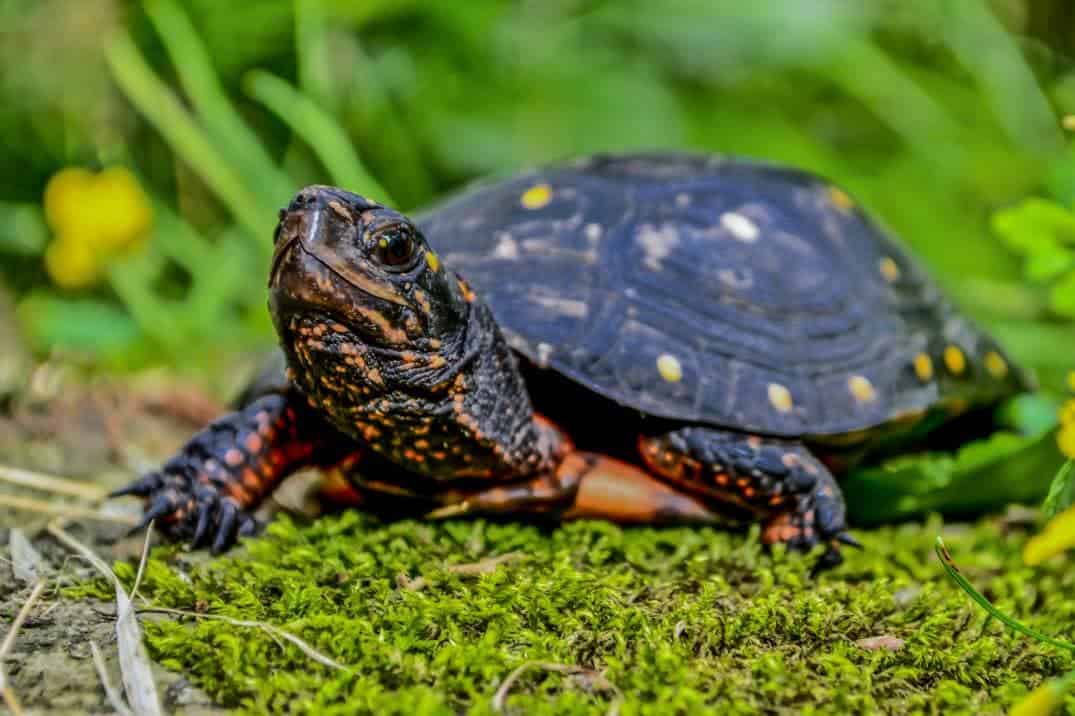Turtles are found in various places throughout Illinois. Rivers, marshes, woods, ponds, and prairies are their favorite spots. Sometimes, you can find them sunning themselves on rocks and logs near water. While the Prairie State is home to 17 different species, there are more than 260 species of turtles in the world!1
This list will help you identify and distinguish the turtles of Illinois, including the Painted Turtle, which is the official state reptile.

The 17 Turtles Found in Illinois
The 2 Softshell Turtles
1. Smooth Softshell Turtle

| Species: | A. mutica |
| Longevity: | 25+ years |
| Good to own as a pet?: | Yes |
| Legal to own?: | Yes |
| Adult size: | 4.5–14 inches |
| Diet: | Omnivorous |
The Smooth Softshell Turtle can be found in rivers that have sandy bottoms and sandbars near them, where the turtles can make their nests. Humans are their biggest predators, followed by raccoons, eagles, and alligators. This turtle enjoys feasting on fish, amphibians, and insects. They’re also known to eat algae. Their shell is soft and flexible, with a smooth, leathery feel and appearance. They have a long, tube-shaped nose that turns up at the end. They’re olive, tan, or brown, with webbed feet and white stripes next to their eyes. The Smooth Softshell Turtle can stay underwater for very long periods of time.
2. Spiny Softshell Turtle
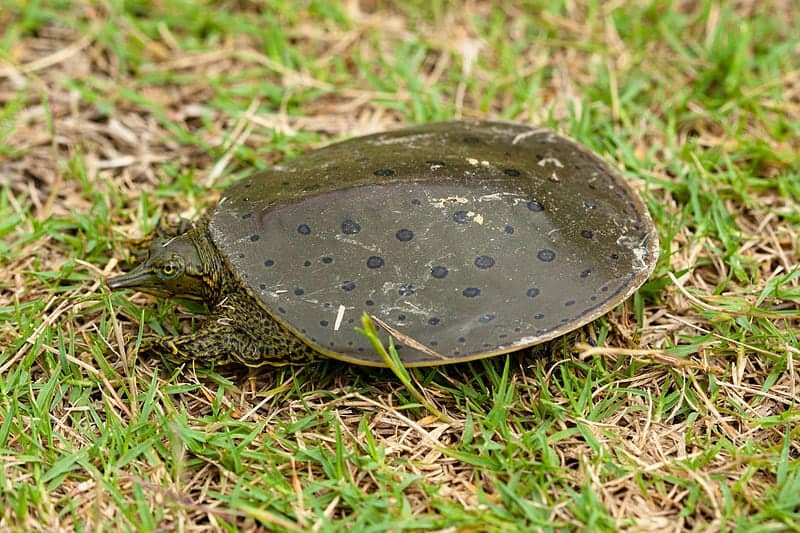
| Species: | A. spinifera |
| Longevity: | 50 years |
| Good to own as a pet?: | Yes |
| Legal to own?: | Yes |
| Adult size: | 5–19 inches |
| Diet: | Carnivorous |
You’ll find the Spiny Softshell Turtle hanging out in or near ponds, lakes, and rivers. They’ll eat anything that they can find, including fish, shrimp, worms, insects, plants, and algae. Foxes, skunks, and raccoons are their biggest hunters. This turtle is similar in appearance to the Smooth Softshell with a few slight differences. Their shells are spotted black and covered in small, cone-shaped spikes that give them a rough feel. Their upturned noses enable them to breathe easily when they’ve buried themselves in mud or sand.

The 3 Mud and Musk Turtles
3. Yellow Mud Turtle

| Species: | K. flavescens |
| Longevity: | 15–40 years |
| Good to own as a pet?: | No |
| Legal to own?: | No |
| Adult size: | 3–6 inches |
| Diet: | Omnivorous |
The Yellow Mud Turtle eats earthworms, fish or reptile eggs, insects, and vegetation. They will eat in the water and on land. They don’t have many natural predators as adults, but eggs and babies are sometimes eaten by snakes and birds. You’ll find this small turtle living in sand prairies along the Illinois and Mississippi Rivers. They have olive-brown heads and upper shells with yellow necks and lower shells.
4. Eastern Mud Turtle

| Species: | K. subrubrum |
| Longevity: | 30–50 years |
| Good to own as a pet?: | No |
| Legal to own?: | No |
| Adult size: | 3–4 inches |
| Diet: | Carnivorous |
In freshwater ponds, wet fields, or ditches, you can find the Eastern Mud Turtle. They move around quite a bit on land and don’t always stay in the water. They eat insects, earthworms, and tadpoles. Herons and alligators are hunters of the adult Mud Turtle. You can identify this turtle by their smooth pattern-less shell that ranges from yellow to dark brown. The neck and throat are yellow and gray with patches of brown.
5. Eastern Musk Turtle

| Species: | S. odoratus |
| Longevity: | 50+ years |
| Good to own as a pet?: | Yes |
| Legal to own?: | Yes |
| Adult size: | 2–4.5 inches |
| Diet: | Omnivorous |
The Eastern Musk Turtle is also called the Stinkpot due to the unpleasant, musky odor that they release whenever they feel threatened. They eat algae and seeds, along with crayfish, insects, and tadpoles. They can be hunted by foxes, Snapping Turtles, and water snakes. They prefer shallow bodies of water with plenty of vegetation. Their shells are brown or black, and they have two yellow stripes on their faces toward their necks.

The 10 Basking, Marsh, and Box Turtles
6. Pond Slider
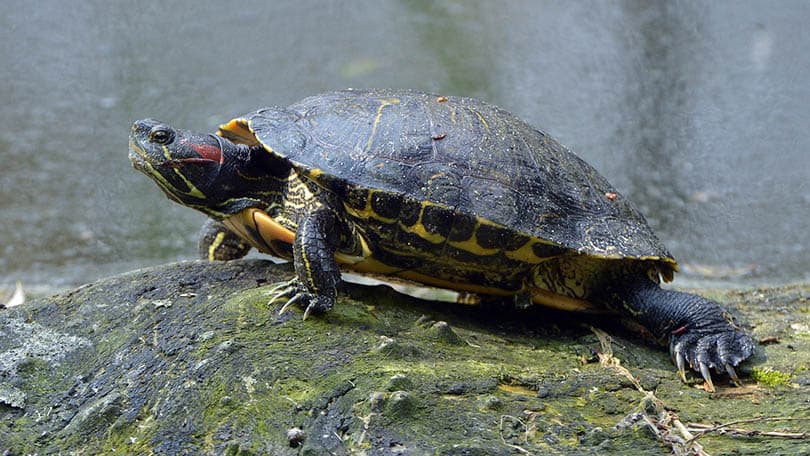
| Species: | T. scripta |
| Longevity: | 20–30 years |
| Good to own as a pet?: | Yes |
| Legal to own?: | Yes |
| Adult size: | 5–11.5 inches |
| Diet: | Omnivorous |
The Pond Slider can be found in ponds or slow-moving rivers that have plenty of places for this turtle to bask in the sun. They have green shells with yellow markings, yellow bottom shells, and green and yellow-striped skin. They primarily eat plant matter, like algae, water lilies, and hyacinths. Sometimes, they enjoy fish, worms, grubs, and other insects. Their predators include raccoons, snakes, birds, and humans.
7. Ornate Box Turtle
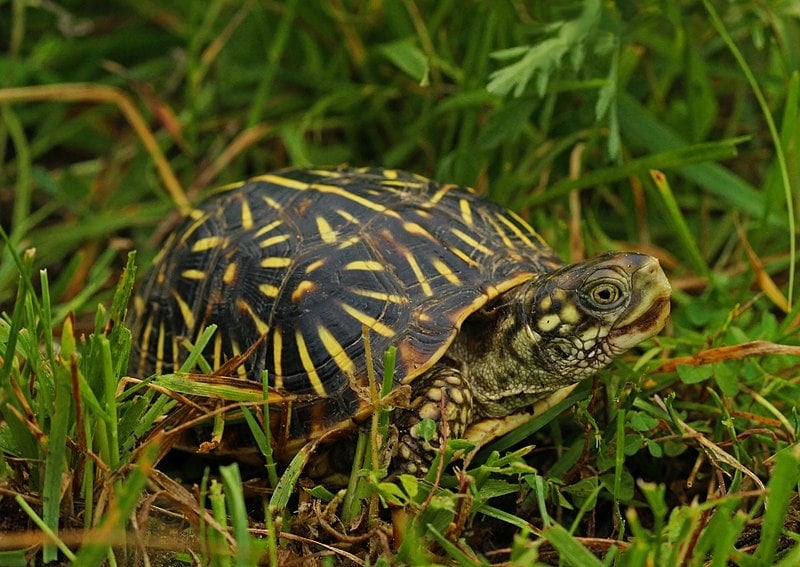
| Species: | T. ornata |
| Longevity: | 32–37 years |
| Good to own as a pet?: | Yes |
| Legal to own?: | Yes |
| Adult size: | 5–6 inches |
| Diet: | Omnivorous |
The Ornate Box Turtle lives in the sand prairies of northern and southern Illinois, where they like to bury themselves to escape harsh weather conditions. Twice a day, they venture out to eat a diet of caterpillars and grasshoppers, but they will also eat berries and other vegetation. Cats, dogs, crows, and raccoons have been known to hunt this turtle. They have a round upper shell that is dark brown with yellow markings. The skin is green or dark brown with yellow markings. Their eyes are either red in males or yellow in females.
8. Woodland Box Turtle

| Species: | T. carolina |
| Longevity: | 25–35 years |
| Good to own as a pet?: | Yes |
| Legal to own?: | Yes |
| Adult size: | 4.5–6 inches |
| Diet: | Omnivorous |
The Woodland Box Turtle is found in woodlands, mudholes, and fields in southern Illinois. They also enjoy swamps and ponds. They have a dome-shaped shell that’s dark brown or olive with markings of yellow, orange, and green. Their diet consists of berries, plants, insects, and amphibians. They can completely enclose themselves in their shells, making it difficult for predators to attack. Like the Ornate Box Turtle, the males have red eyes. The females have brown eyes.
9. River Cooter

| Species: | P. concinna |
| Longevity: | 40+ years |
| Good to own as a pet?: | No |
| Legal to own?: | No |
| Adult size: | 10–14 inches |
| Diet: | Herbivorous |
The River Cooter is a basking turtle and can be found along rivers that have plenty of aquatic plants and spots to bask in the sun. They will leave their lounging spot twice a day to search for leaves, algae, berries, and plants near the water. Their shells are olive and dark brown with yellow markings. These yellow markings appear on the head and neck. Predators of this turtle include muskrats, alligators, and humans. Unfortunately, they are often killed and eaten by people or captured and sold as pets.
10. False Map Turtle

| Species: | G. pseudogeographica |
| Longevity: | 35+ years |
| Good to own as a pet?: | Yes |
| Legal to own?: | Yes |
| Adult size: | 6–12 inches |
| Diet: | Carnivorous |
In the streams of the Mississippi River, you’ll find the False Map Turtle. This aquatic turtle loves to eat fish, even dead ones. They will also eat insects, mollusks, and other aquatic life. Red foxes and otters are their natural predators. The shell is olive or dark brown, and yellow lines mark the top, giving the shell a map-like appearance. These markings are where the turtle gets their name. The markings will fade as the turtle ages, becoming less noticeable.
11. Ouachita Map Turtle

| Species: | G. ouachitensis |
| Longevity: | 30–50 years |
| Good to own as a pet?: | Yes |
| Legal to own?: | Yes |
| Adult size: | 3.5–10.25 inches |
| Diet: | Herbivorous |
The Ouachita Map Turtle is commonly seen in Illinois lakes and rivers. They feast on snails, crayfish, worms, and plants. This turtle is prey for raccoons and herons. Their shell is brown or olive, with yellow lines and circles patterning the top. They have a noticeable ridge down the top center of the shell, and the rear edge of the shell is jagged. There are yellow marks behind each eye. The turtle is named after the Ouachita (WAH-shi-tah) River that runs through Arkansas and Louisiana.
12. Northern Map Turtle
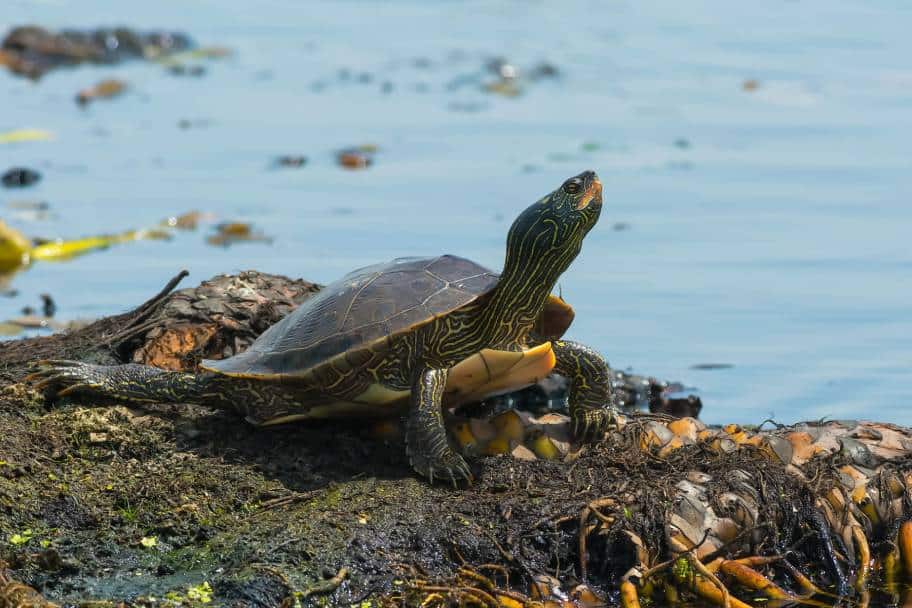
| Species: | G. geographica |
| Longevity: | 15–20 years |
| Good to own as a pet?: | Yes |
| Legal to own?: | Yes |
| Adult size: | 4–11 inches |
| Diet: | Carnivorous |
The Northern Map Turtle is found in lakes or ponds, coming out of the water to bask in the sun. They love to eat mollusks, insects, and crayfish. Raccoons, possums, and coyotes feed on these turtles. The “map” lines on their dark shells are orange, tan, or yellow. They have dark brown or olive limbs and tails. This turtle will join other Map Turtles at the bottom of the lake in the winter to hibernate under logs and rocks.
13. Blanding’s Turtle
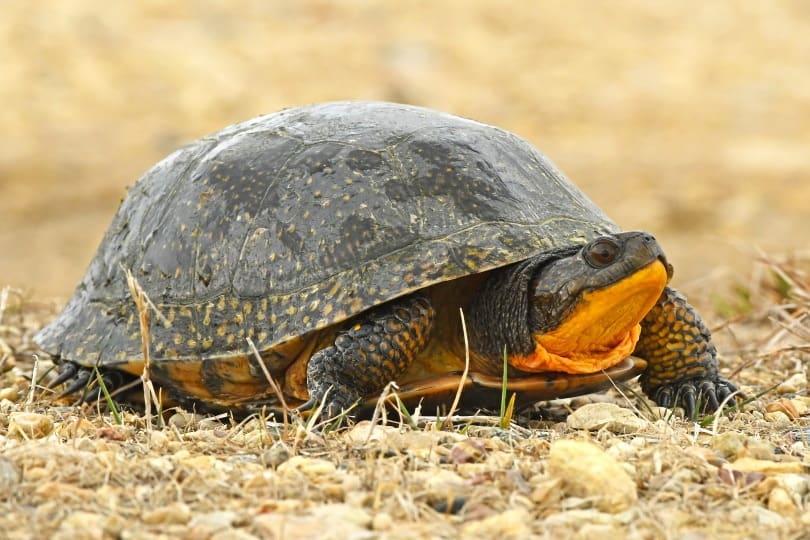
| Species: | M. blandingii |
| Longevity: | 75–80 years |
| Good to own as a pet?: | No |
| Legal to own?: | No |
| Adult size: | 7–10 inches |
| Diet: | Omnivorous |
The loss of much of their natural habitat caused the Blanding’s Turtle to become endangered in Illinois. They’re typically found in the marshes, streams, and bogs of northern Illinois. In addition to their black or brown shell speckled with yellow, these turtles are most easily identified by their bright yellow chins and necks. Their limbs are shiny black with yellow spots. The Blanding’s Turtle eats plants, grasses, snails, berries, and insects. Foxes, raccoons, and skunks eat their eggs, which threatens their existence even further.
14. Spotted Turtle

| Species: | C. guttata |
| Longevity: | 26 years |
| Good to own as a pet?: | No |
| Legal to own?: | No |
| Adult size: | 3.5–5 inches |
| Diet: | Omnivorous |
The Spotted Turtle is found in wetlands, marshes, and small bodies of shallow, plant-filled water. This small turtle enjoys eating insects, amphibian eggs, crustaceans, and aquatic plants. They are usually hunted by raccoons and muskrats while they are basking in the sun. If they sense that danger is near, they will quickly dive into the water and hide in the mud at the bottom. This beautiful turtle has a smooth dark gray or black shell covered in bright yellow spots, resembling drops of spilled paint. Yellow spots also appear on their limbs. These spots fade as the turtle gets older.
15. Painted Turtle
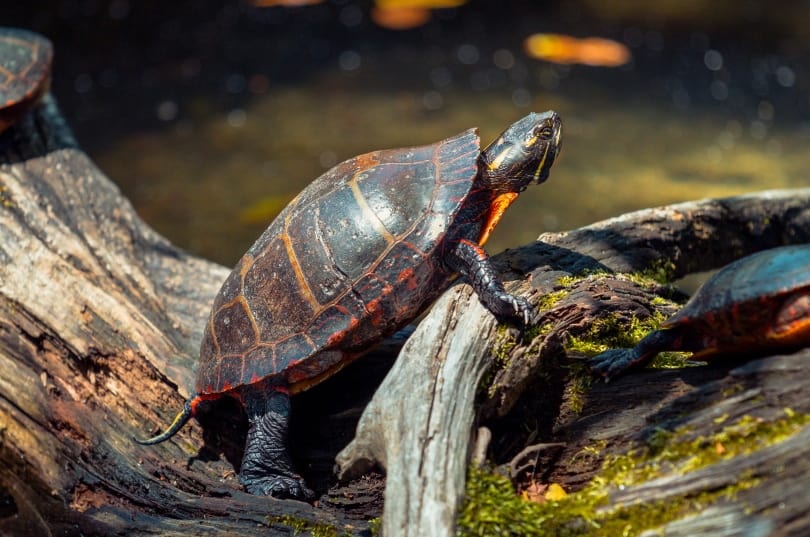
| Species: | C. picta |
| Longevity: | 20–25 years |
| Good to own as a pet?: | Yes |
| Legal to own?: | Yes |
| Adult size: | 5–6 inches |
| Diet: | Omnivorous |
The Illinois state reptile, the Painted Turtle, is found in slow-moving rivers and shores of lakes with muddy bottoms. Young Painted Turtles are carnivorous, but they become omnivores as they age. They love carrion, fish, and insects. Few animals hunt the Painted Turtle as an adult, but hatchlings and eggs are often eaten by skunks, alligators, and snakes. A smooth dark shell with blotches of red, green, and yellow give this turtle their painted look. They have yellow stripes on their legs and faces.

The 2 Snapping Turtles
16. Alligator Snapping Turtle

| Species: | M. temminckii |
| Longevity: | 100 years |
| Good to own as a pet?: | No |
| Legal to own?: | No |
| Adult size: | 22–29 inches |
| Diet: | Carnivorous |
The Alligator Snapping Turtle is big and cranky and resembles an old dinosaur. Weighing up to 175 pounds, it’s the largest freshwater turtle in the world! You’ll find them in freshwater lakes, rivers, and canals. Unfortunately, this turtle is also endangered. Humans are their biggest predators, and capturing or owning this turtle is illegal.
Mainly dark brown or olive, this turtle looks like a giant rock, and they will sit on the bottom of a body of water with their mouth open, waiting for fish to swim by. The turtle’s tongue resembles a worm, which attracts the unsuspecting fish. Fish are their favorite food, but they eat vegetation too. They’re considered mostly carnivorous. They have three large ridges on top of their hard shell, a huge blocky head, and a hooked beak.
The Alligator Snapping Turtle can snap a broomstick in half with a single snap. They’ve been rumored to have chomped off human fingers. If you happen to encounter this turtle, it’s a good idea to stay away from them!
17. Snapping Turtle
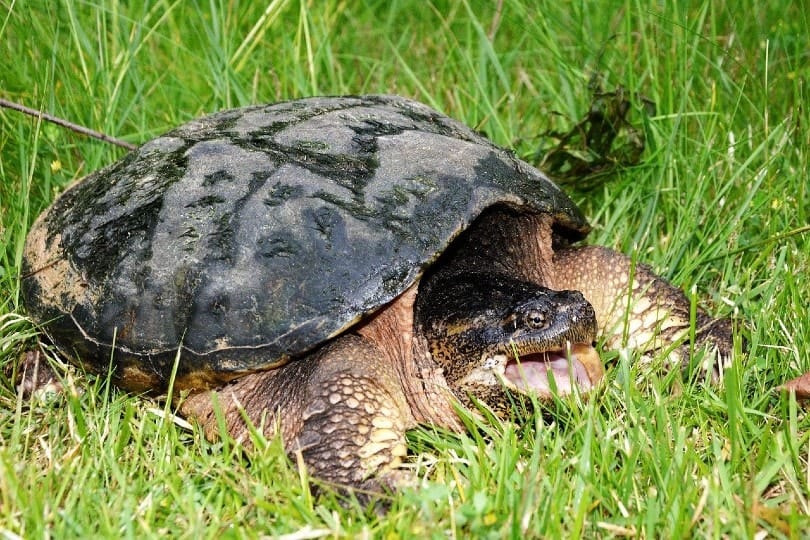
| Species: | C. serpentina |
| Longevity: | 30 years |
| Good to own as a pet?: | No |
| Legal to own?: | Yes |
| Adult size: | 8–14 inches |
| Diet: | Omnivorous |
Common Snapping Turtles spend their time in freshwater ponds and streams, hiding in the aquatic plants. Their shells are deep brown, green, or black and get covered with algae over time. This enables them to camouflage even better in their surroundings. Their heads are dark and they have yellow limbs. Their tails have ridges on the top. They like to bury themselves in mud to wait for their prey, such as fish, amphibians, and birds. They also hide from their known predators, including foxes and crows. However, if they are caught, they will fight back viciously and can snap the heads off of certain creatures that are trying to harm them.
They may not be as big as the Alligator Snapping Turtle, but it’s still best to not try to handle them. They can bite even if they are picked up from their sides.

Conclusion
Now that you know about the 17 species of turtles found in Illinois, be on the lookout for them the next time that you’re in the area. Enjoy watching these beautiful animals in their natural environments. Some species are more commonly seen than others, but if you’re lucky enough to spot one, we hope that this list helps you figure out what kind of turtle you’re seeing. Remember to avoid snapping turtles, and keep an eye out for the state reptile, the Painted Turtle!
Featured Image Credit: Jay Ondreicka, Shutterstock
